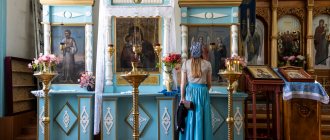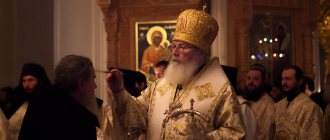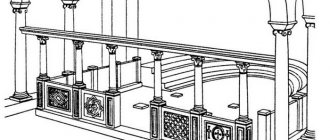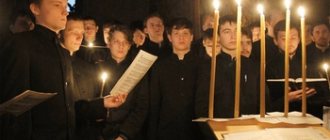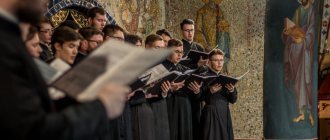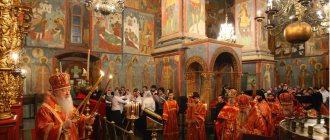Text of the Great Doxology
Listen:
Glory to God in the highest, and on earth peace, good will toward men. We praise Thee, we bless Thee, we bow to Thee, we glorify Thee, we thank Thee great for the sake of Thy glory. Lord, Heavenly King, God, Father Almighty, Lord, Only Begotten Son, Jesus Christ, and Holy Spirit. Lord God, Lamb of God, Son of the Father, take away the sin of the world, have mercy on us. Take away the sin of the world, accept our prayer. Sit at the right hand of the Father, have mercy on us. For You are the only Holy One; You are one Lord, Jesus Christ, to the glory of God the Father, amen. I will bless You every day and praise Your name forever and ever. Grant, Lord, that on this day we may be preserved without sin! Blessed are you, O Lord God of our fathers, and praised and glorified is your name forever, amen. May Thy mercy be upon us, O Lord, as we trust in Thee. Blessed art thou, O Lord, teach me by thy justification (three times). Lord, you have been our refuge throughout all generations. Az said: Lord, have mercy on me, heal my soul for those who have sinned against You. Lord, I have come running to You: teach me to do Your will, for You are my God, for You are the source of life, in Your light we will see light. Extend* Your mercy to those leading You! Holy God, Holy Mighty, Holy Immortal, have mercy on us! (three times). Glory to the Father and the Son and the Holy Spirit, now and ever and unto ages of ages, amen. Holy Immortal One, have mercy on us. Holy God, Holy Mighty, Holy Immortal, have mercy on us!
Take up - lifting. Try it - stretch it.
***
Great Doxology
Archpriest Dimitry Kuvirtalov
“Glory to You, who showed us the light” - with this exclamation at the end of the all-night vigil, the ancient Church welcomed the beginning of a new day. The Great Doxology - one of the most ancient hymns of the Church - glorifies God the Creator, Provider, Redeemer, Savior and Life-Giver. In this sublime and solemn song we praise, bless, worship, glorify and thank God. Here we confess the Divine Names, through which, like through the rays of the sun, we are touched by Divine warmth, joy and strength.
The central part of the Doxology is the story of our salvation, accomplished by Jesus Christ not for our merits, but according to the ineffable and incomprehensible mercy of God towards us.
“In Your light we will see light.” The Doxology ends with great rejoicing. A person filled with sinful darkness is enlightened by the feeling of the Divine presence. Becoming light, he sees himself next to God as unenlightened darkness; illuminated by the grace of God, he becomes able to see God - “In Your light we will see light! Extend, O Lord, Your mercy to those who know You.”
The Church knows three types of prayer - petition, thanksgiving and doxology. When the soul is filled with the mercies of God, when it thanks God for everything sent down to it, then in reverent delight it glorifies, sings and extols the Life-Giving Trinity. Therefore, the Great Doxology ends with the singing of the Trisagion.
Man cannot live without God; man is akin to God. God made us Himself... Man glorifies God, acquiring a heavenly state of soul.
Synonyms
As an example, the most suitable of them are:
- Hosanna;
- hymn;
- panegyric;
- praise;
- Akathist;
- chant;
- prayer;
- Oh yeah;
- psalm;
- song;
- a word of praise;
- eulogy;
- praise;
- glorification;
- praise;
- dithyramb;
- glorification;
- praising;
- praising;
- exaltation;
- praise;
- praise;
- incense;
- prayer;
- exaltation;
- chanting;
- honoring;
- compliment;
- ascension;
- triumph;
- madrigal;
- Ascension;
- ovation;
- OK;
- apotheosis;
- prayer;
- prayer service
In continuing to consider the question of what this is “doxology”, it would be advisable to delve into the origin of the lexeme being studied.
Contents of the Great Doxology
Mikhail Skaballanovich. Explanatory Typikon
The doxology itself begins with an angelic song at the birth of the Savior, after which Matins, already nearing its end, returns to its beginning (a favorite device in church songs). Such a high, heavenly song sanctifies our lips (as before Matins) for our own song, which begins with the words: “we praise (actually: “sing”) Thee, we bless Thee, we bow to Thee” (cf. the conclusion to the recent 8th song of the canon), reminiscent in their brevity and generality of the greatest song of the liturgy (“We sing to you”): no matter how it is indicated, for what we sing, we bless and thank the Lord and what we pray to Him for, because then we give thanks for everything and pray for to everyone and the list would be endless, so this is not indicated here either, but the supreme reason for our praise, worship and thanksgiving is indicated - the great glory of God.
This glorification of God in song is followed by a prayer to Him, the transition to which is a prayerful appeal to all the persons of the Holy Trinity separately. From the Holy Trinity, prayer is directed mainly to our Intercessor in heaven, the Lamb of God (the favorite name of the Savior among ancient Christians), from Whom we ask for mercy (the main request of all vigil prayers - litanies), conditioned, among other things, by the acceptance of our present (long and already nearing the end) of prayers.
To be sure of the success of this petition, it consists of that solemn confession of Christ, which is proclaimed at the liturgy just before the communion of the Holy Mysteries: “(For You are) the only Holy One, (You are) the only Lord, Jesus Christ, to the glory of God the Father” (immeasurable the presence of such a Son further increases the glory of God, although there seems to be nowhere to increase it). This ends the first part of the great doxology, which concludes with the first “Amen” in it.
The second part is no longer so joyful and enthusiastic, moreover, like the 3rd part, it is almost entirely compilative - made up of the words of Holy Scripture. The glorification of God that fills it (“every day”, therefore also in the coming one, “let us bless You”, because Your name will be glorified forever - from Ps. 144, 2nd glorified earlier: “Blessed art thou, O Lord God of our fathers " - Dan. 3:25), is darkened here by the consciousness of our sinfulness, which can, as it were, disrupt and interrupt this eternal glorification (cf. “to the glory ..." of the end of the 1st part) of God with one sinful day, from which may God save us Today. Second "amen".
The third part is exclusively prayerful. The repentant sorrow here is already so intensified that the joyful glorification of God, with which the great praise began and which should be its main subject, barely breaks through here and there in individual expressions (“Blessed are you, the Lord” - Ps. 119:12). This part begins with prayer, and not with praise, in contrast to the first two, with a prayer of a general nature for the mercy of God, but dissolved by hope in God (“Be, O Lord, Thy mercy upon us, as we trust in Thee” - Ps. 32:22) .
This general prayer then takes on a more specific character and comes down to a request from God to teach us His justifications, a request expressed in the words of Ps 118: “Blessed art thou, O Lord, teach me by Thy justification” and repeated three times - to the 3 Persons of the Holy Trinity (and This repetition is done not with a change in the text, as at Vespers in “Lord Vouchsafe,” but with literal precision, which enhances the effect).
Further, this still rather general request is developed and explained: in order to realize God’s justifications in life, one needs cleansing from sins and the ability to do the will of God. Both can be given only by God Himself, to Whom we must resort for help, as everyone has always resorted to Him (“Lord, you have been a refuge for us throughout generation and generation” - Ps. 89:1); First, cleansing from sins is asked from Him (in the words of Ps. 40:5: “Az reh” - a strong request: “Lord, have mercy on me, heal my soul, for those who have sinned against You”); and then even more intensely (“Lord, I have come to You...”) - teaching His will (Ps. 142:9).
Prayer consists of firm confidence in its fulfillment, justified (as in the exclamations after the litany: “As You are”) on the special closeness to us of God (“My God,” Ps. 143:9,10), the source of life and light (“in in Your light we will see the light,” that is, the morning light - a return to the initial exclamation of the great doxology at the end of it). With your last words: “extend (extend) Your mercy to those who lead You,” together with the previous ones: “As You have...” (Ps. 35:10,11) the third part of the great doxology returns to its beginning, and its initial petition for God’s mercy to us (“wake up”) is intensified here (“probavi”).
It is impossible not to notice that the indicated connection between the individual sentences of this long song is not very close; the transitions in it from one thought to another are quite unexpected. The song, in fact, consists of fragmentary exclamations of prayer and praise, each of which is too complete, complete in itself, to require continuation or completion. All expressions are taken from Holy Scripture, and the strongest ones are selected from there.
***
At weekday (non-doxology) and Lenten holiday matins, as well as at Compline, the Great Doxology is replaced by the reading of the daily doxology.
Statutory features relating to the Great Doxology[ | ]
Cases of using the great doxology[ | ]
The Great Doxology is sung at festive vigils, polyeleos and doxologies
worship services.
Small
(without polyeleos) holiday services with the singing
of the Great Doxology
in Orthodox monthly books are marked with a distinctive sign: - a red bracket with three dots inside.
However, the doxological
services
of
Easter, the Twelve Feasts, and Mid-West are not marked with this sign.
Other glorifying
holidays:
- Lord's:
*Beginning of the indictment (church new year) September 1 (14), commemoration of the renovation of the Church of the Holy Sepulcher September 13 (26), Origin of the honorable trees of the Life-giving Cross August 1 (14), transfer of the Image Not Made by Hands August 16 (29), Lazarus Saturday, Holy Saturday, Midsummer, Spiritual Day. - Theotokos:
Conception of the Blessed Virgin Mary by righteous Anna December 9 (22), Council of the Blessed Virgin Mary December 26 (January 8), Council of the Archangel Gabriel March 26 (April 8), Position of the Robe of the Virgin Mary in Blachernae July 2 (15), Dormition of Anna the mother of the Blessed Virgin Mary 25 July (August 7), Saturday Akathist. - In memory of the saints:
John of Novgorod on September 7 (20), Joseph of Volotsk on September 9 (22), Prince Theodore of Smolensk on September 19 (October 2), Prince Michael and the boyar Theodore on September 20 (October 3), the conception of John the Baptist on September 23 (October 6) , Savvaty of Solovetsky and ***Metropolitan Peter of Krutitsky on September 27 (October 10), Gregory of Pelshemsky on September 30 (October 13), Savva of Vishera on October 1 (14), Gury of Kazan on October 4 (17), **Holy Hierarchs of Moscow 5 (18) October, Apostle James, brother of God on October 23 (November 5), Arseny of Serbia and the martyr Paraskeva on October 28 (November 10), ****Abraham of Rostov on October 29 (November 11), Jonah of Novgorod on November 5 (18), Varlaam of Khutyn 6 ( November 19 and on the first Friday of Peter's Lent, ***** Blessed Maxim of Moscow November 11 (24), Nikon of Radonezh November 17 (30), Barlaam and Joasaph of India November 19 (December 2), ** Alexander Nevsky November 23 ( December 6), ***Filaret the Merciful December 1 (14), Savva of Zvenigorod December 3 (16), Nil Stolobensky December 7 (20) and May 27 (June 9), ***Simeon of Verkhoturye December 18 (31), Cathedral John the Baptist January 7 (20), Savva of Serbia January 12 (25), Nikita of Novgorod January 31 (February 13), Demetrius of Prilutsky February 11 (24), Arseny of Tversky March 2 (15), Euthymius of Novgorod March 11 (24), Makaria Kalyazinsky on March 17 (30), Evfimy of Suzdal on April 1 (14), Zosima of Solovetsky on April 17 (30), Stefan of Perm on April 26 (May 9), **Paphnuty Borovsky on May 1 (14), Isaiah of Rostov and **Tsarevich Dimitri 15 (28) May, Ephraim of Perekomsky on May 16 (29), Cornily of Komelsky on May 19 (June 1), **Alexy of Kiev on May 20 (June 2), Prince Konstantin of Murom on May 21 (June 3), Leonty of Rostov on May 23 (June 5 ), Nikita Pereyaslavsky on May 24 (June 6), Kirill Beloezersky on June 9 (22), ***Tikhon Lukhovsky on June 16 (29), Princes Peter and Fevronia on June 25 (July 8) and on the Sunday before September 6 (19), *Council of the Twelve Apostles June 30 (July 13), **Sergius of Radonezh and ***Reverend Martyr Elizabeth July 5 (18), ***Euphrosyne of Moscow July 7 (20), **Antony of Pechersk July 10 (23), Macarius of Zheltovodsk July 25 (August 7), ***Moisey Ugrin July 26 (August 8), ***Veniamin of Petrograd July 31 (August 13), St. Basil's August 2 (15), Anthony of Rome August 3 (16), Abraham of Smolensk 21 August (September 3), Metropolitan Peter of Kiev on August 24 (September 6); Saturday of cheese week.
*In the Typikon it is marked as polyeleos -, but in modern parish practice a doxological service is performed. **In the Russian Orthodox Church, a polyeleos is usually performed for these saints. ***The memory of these saints has not yet been included in the current Typikon. ****Usually, daily worship is performed without a holiday sign. *****In the Typikon it is marked “service on 6
” -.
The Great Doxology is missing:
- in funeral hallelujah services;
- in weekday and six-day services, and also if the holidays fall on weekdays from Monday to Friday of Great Lent[4], when instead of singing the Great Doxology in choir, at Matins one reader recites the daily Doxology, which is read in almost the same way at Compline;
- on Easter and throughout Bright Week, despite the maximum solemnity of the divine service, the great doxology
(as well as the polyeleos) is not performed, except in cases where the Annunciation occurs on these days on March 25 (April 7), the memory of the Great Martyr George the Victorious on April 23 (May 6) or patronal holiday.
The order of the doxological service[ | ]
When performing praises
services usually:
- At “ The Lord has called...
” (vespers) the 6th stichera are sung only for the holiday or the “
doxifying
” saint being celebrated (usually each of the three stichera in the Menaion (or Colored Triodion) is sung twice. At “
And now...
” - Sunday dogmatist according to the voice of the stichera on “
Glory...
”, on Saturday - the dogmatist
of the outgoing
voice; - At Vespers stichera, 3 stichera of the holiday are sung with their own “verses.” On “ And now...
” the verse Theotokion is sung (in some cases from the festive 1st appendix of the Menaion, but in some from the daily 2nd appendix) according to the voice of the stichera “Glory”; - At the end of Vespers, after the troparion, the Theotokos of the festive (3rd) supplement is sung to the saint according to the voice of the troparion. The same Theotokos is sung two more times: at the beginning and at the end of Matins, after the singing of the troparion of the holiday. If the feast is the Lord's or the Theotokos, then after the troparion there is no feast of the Theotokos;
- In Small Compline for Trisagion - kontakion of the holiday;
- Midnight Office - daily;
- Two kathismas according to the Rule (if the doxology is performed during the winter schedule [verses of the Psalter], then the third kathisma is transferred to the vespers of the coming day [5]. Sedalny on kathismas with the Mother of God - from the Menaion;
- Each hymn of the canon of Matins consists of: irmos, three troparions of the first canon of Octoechos, four troparions of the second canon of Octoechos, five (if there are fewer troparia in the Menaion, then the reader recites the first (or all) troparia twice) troparions to the celebrated saint and the Mother of God. However, in the case of the Mother of God feasts and the celebration of the twelve feasts, the Octoechos is not used, and all 14 troparions in each song of the canon are festive. The choir sings a festive chaos after each song of the canon. On Saturday, in the church of the saint, the canon of the church is no longer read;
- Luminary to the saint (twice), “ Glory... and now...
”, theotokos; - 4 stichera to the saint on “ Praise...
”, another one is sung on “
Glory...
”.
On “ And Now...
” the verse Theotokos from the festive 1st appendix is sung according to the voice of the stichera “Glory”; - A great doxology
is sung .
In liturgical practice, the custom has taken root during the Great Doxology
to open the Royal Doors, and the priest to put on a phelonion[6], emphasizing the festive end of Matins, but the dismissal can also be daily; - Troparion and kontakion of the holiday at every hour;
- On “ Blazheni...
” there are 4 troparions for the third song of the canon of the holiday and 4 troparions for the sixth; - Upon entering with the Gospel, troparia and kontakia are sung in daily order, only on “ Glory...
” the kontakion of the holiday is sung, and not “
Rest with the saints...
”; - Prokeimenon, Alleluia and Communion - the day of the week and the holiday;
- The Apostle and the Gospel are ordinary (the next conceptions, counted from Easter) and the holiday.
Special performances of doxology[ | ]
If the service is led by a bishop, then at the beginning of the singing of the great doxology he leaves the altar through the royal doors to the pulpit and overshadows the worshipers with the trikyrius and dikiriy on four sides.
At the all-night vigil on the eve of the Cross Veneration (3rd) Week of Lent, the Origin of the Venerable Trees of the Holy Cross on August 1 (14), and the Exaltation of the Holy Cross on September 14 (27), before the Great Doxology, the rector puts on full vestments (as at the liturgy), and when singing the Trisagion carries out the removal of the Cross.
At Matins of Great Saturday (served in the evening on Good Friday), the primate puts on full vestments, and before the doxology, the priests from the altar go out to the middle of the temple to the shroud, and while singing the Trisagion, they take the shroud and begin the rite of burial of the Savior - a procession with the shroud around the temple[ 7]. The same thing is done at the rite of burial of the Mother of God (can be done on any day after the Assumption).
Text of the daily doxology:
Glory to God in the highest, and on earth peace, good will toward men. We praise Thee, we bless Thee, we bow to Thee, we glorify Thee, we thank Thee, great for the sake of Thy glory. Lord, Heavenly King, God, Father Almighty, Lord, Only Begotten Son, Jesus Christ, and Holy Spirit. Lord God, Lamb of God, Son of the Father, take away the sin of the world, have mercy on us. Take away the sin of the world, accept our prayer. Sit at the right hand of the Father, have mercy on us. For You are the only Holy One; You are one Lord, Jesus Christ, to the glory of God the Father, amen.
Every night I will bless You and praise Your name forever and ever.
Lord, you have been our refuge throughout all generations. Az said: Lord, have mercy on me, heal my soul for those who have sinned against You. Lord, I have come to You, teach me to do Your will, for You are my God, for You are the source of life, in Your light we will see light. Show Your mercy to those who lead You.
Etymology
The noun under study is formed from two others, “glory” and “word”. Each of them will be considered separately below.
The noun “glory” is interpreted in the dictionary as widespread fame, honor, admiration. In a figurative sense, it means praise, gratitude. It comes from the Proto-Slavic slava, from which also came:
- Old Russian and Old Slavonic “glory”;
- Ukrainian, Belarusian, Bulgarian “slava”;
- Serbo-Croatian "glory";
- Slovenian, Czech and Slovak sláva;
- Polish, Upper Luga and Lower Luga sɫaw a.
The lexical unit being studied is connected by the alternation of vowels with the verb “reputed”. The meaning of the latter is “to be considered as someone, something”, “to be known as someone or something”.
Related to nouns such as:
- Lithuanian šlóvė – “praise”, “honor”;
- Eastern Lithuanian šlãvė – “glory”, “honour”, šlovė – “luxury”, “splendor”;
- Latvian slava, slave – “rumour”, “glory”;
- Greek κλέος - “glory”;
- Old Indian c̨rávas – “honor”, “glory”, “praise”;
- Avestan sravah – “word”;
- Old Irish - "glory".
And also verbs:
- Old Indian c̨rāváyati – “listen”; “forces”, “proclaims”;
- Avestan sravayeiti - in the same meaning;
- New Persian sarāуīdan – “to sing”;
- Eastern Lithuanian šlãvinti – “glorify”.
As for the lexeme “word”, it has a very large number of meanings, but for the case under consideration it is most suitable to use it in a figurative sense. Here it is interpreted as “verbal expression of a thought or feeling,” “utterance.”
It comes from the Proto-Slavic noun slovo, from which came:
- Old Russian, Old Slavonic, Belarusian, Ukrainian, Bulgarian “word” in the meaning of “letter”, “word”;
- Serbo-Croatian "word" meaning "letter";
- Slovenian slovô – “farewell”, slóvo – “letter, word”, slòv – “name”, “call”;
- Czech slovo – “word”, sloveso – “verb”;
- Slovak slovo – “word”;
- Polish, Upper Luga and Lower Luga słowo;
- Polabian slüvǘ.

